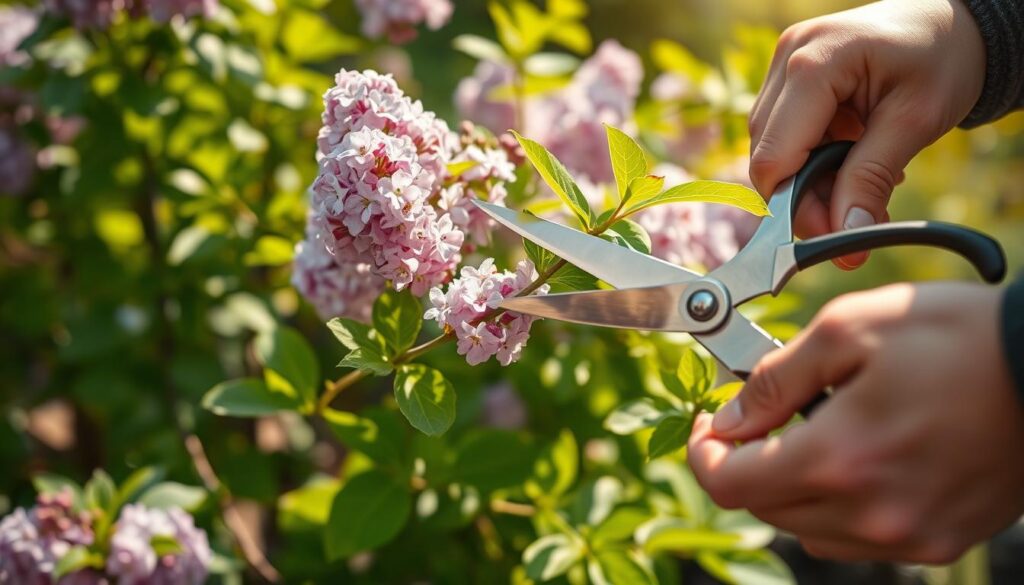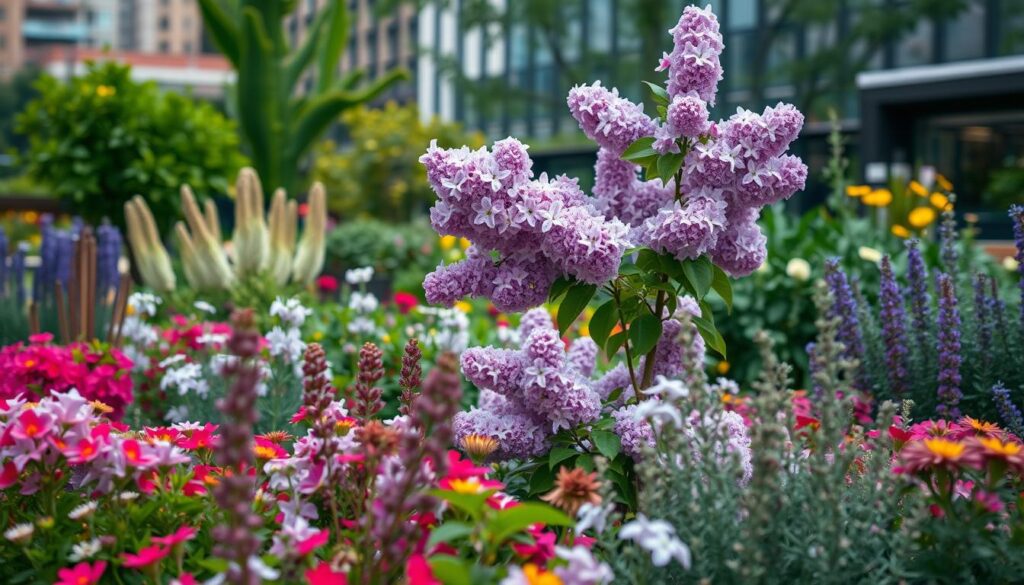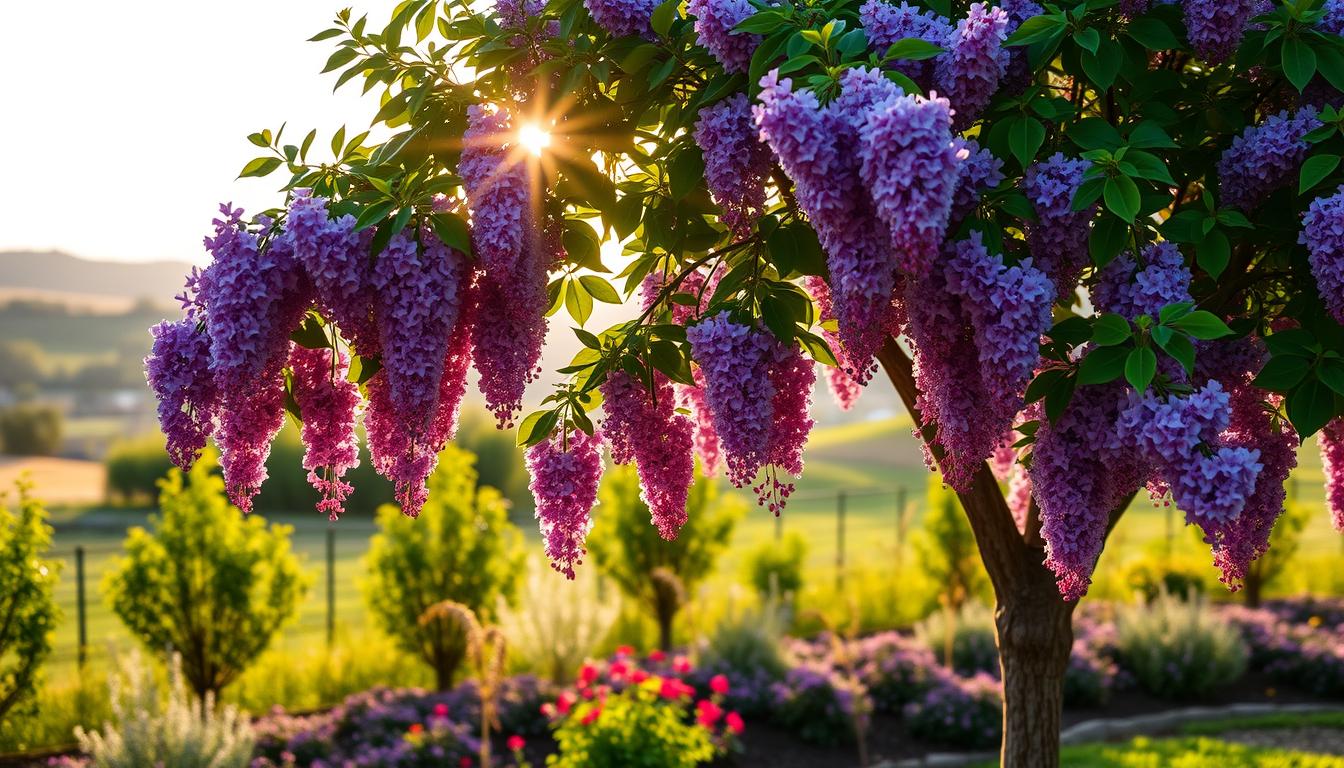Every gardener dreams of a plant that makes their garden beautiful with little work. The dwarf lilac tree is a true garden hero. It charms everyone with its beauty and versatility.
Compact lilacs have changed garden design. They offer a stunning solution that is both beautiful and practical. These small wonders bring lilac charm to places where big bushes won’t fit. They work well in tiny urban balconies and small suburban yards.
Imagine walking through your garden and smelling lilacs. But without the big size of traditional lilacs. These small plants have all the charm of big ones but are easy to handle.
Table of Contents
Understanding the Magic of Compact Lilac Varieties
Gardeners looking for beautiful, space-saving plants have found the charm of syringa shrubs. These miniature lilac bushes have all the beauty of traditional lilacs but are more compact. They have changed landscape design, offering gardeners stunning flowering options.
Dwarf lilacs add diversity to your garden, making small spaces vibrant. They are ideal for urban gardens, small yards, and container plantings.
Common Types of Dwarf Lilacs
- Bloomerang Purple Lilac: Grows 4-5 feet tall
- Dwarf Korean Lilac: Reaches 3-4 feet in height
- Miss Kim Lilac: Compact variety with blue-purple flowers
- Tinkerbelle Lilac: Miniature bush with deep pink blooms
Characteristics of Miniature Lilac Bushes
These compact syringa shrubs have unique features:
- Smaller overall growth footprint
- Extended blooming periods
- Dense, attractive foliage
- Multiple color variations
Size Comparison with Traditional Lilacs
| Lilac Type | Average Height | Spread |
|---|---|---|
| Traditional Lilac | 8-10 feet | 6-8 feet |
| Dwarf Lilac | 3-5 feet | 3-4 feet |
“Dwarf lilacs prove that great things come in small packages!” – Garden Design Magazine
Choosing low-growing lilacs lets you enjoy lilac beauty and fragrance without losing garden space.
The Revolutionary Bloomerang Lilac: A Game-Changing Hybrid
Gardeners looking for something special will love the Bloomerang lilac. These unique dwarf lilac hybrids change the game with their ability to bloom repeatedly.
The Bloomerang lilac does not follow the usual lilac pattern of blooming once in spring. Instead, they bloom multiple times during the growing season. You’ll see beautiful flowers in May, a short break in June, and then again from July until the first frost in autumn.
- First bloom: Vibrant spring flowering in May
- Summer restart: Renewed blooming in July
- Continuous color: Flowers until the first autumn frost
There are many varieties of Bloomerang lilacs to choose from. They fit into any garden, big or small. You can pick from compact dwarf types or slightly larger ones, all offering consistent beauty.
“A garden is never static, and neither are Bloomerang lilacs.” – Gardening Enthusiast
Pollinators like bees, butterflies, and hummingbirds love these lilacs. They’ll visit your garden often and enjoy the nectar from the flowers all season long.
Essential Growing Requirements for Dwarf Lilac Tree Success
To grow patio lilacs well, you need to know their specific needs. Urban lilac plants do best when gardeners meet their basic needs for growth and blooming.
Optimal Soil Conditions for Robust Growth
Your dwarf lilac needs the right soil to grow strong. The best soil is:
- Well-draining
- Rich in organic matter
- Neutral to slightly alkaline (pH 7.0-7.5)
Sunlight and Temperature Preferences
Dwarf lilacs need full sun exposure. They do best with 6-8 hours of direct sunlight each day. These plants can handle very cold temperatures, making them great for many climates.
| Sunlight Need | Temperature Range | Ideal Growing Zones |
|---|---|---|
| Full Sun | -40°F to 90°F | 3-7 |
Precise Watering and Drainage Strategy
Watering is key for patio lilacs. Water deeply but not too often, letting the soil dry between waterings. Good drainage is also important to keep the plant healthy.
- Water 1 inch per week
- Avoid waterlogged conditions
- Mulch to retain moisture
Year-Round Beauty: Multiple Blooming Seasons
Gardeners looking for color and scent all year will love reblooming lilacs. These special shrubs change your garden by blooming many times a year. Unlike regular lilacs, they bloom for longer, adding beauty to your garden.
The Bloomerang lilac is a standout in fragrant lilacs. It blooms for months, keeping your garden lively. Here’s how it blooms:
- Heavy spring bloom in May
- Short rest period in June
- Renewed flowering from July until the first frost
With the right reblooming lilacs, your garden will have many beautiful blooms. These shrubs not only look great but also smell amazing. They attract pollinators and make gardeners happy.
Pro Tip: Choose dwarf reblooming lilac varieties for consistent color in smaller garden spaces.
To get your lilacs to bloom all season, you need to care for them right. Consistent pruning, enough sunlight, and the right soil are key. Knowing how they grow helps you get the most out of these amazing plants.
Perfect Placement: Where to Plant Your Dwarf Lilac
Choosing the right spot for your patio lilacs can turn your outdoor area into a lively masterpiece. These urban lilac plants are great for many garden types and container setups.
Container Growing Options
Dwarf lilacs do well in pots, making them perfect for tight spaces and city gardens. When picking a pot for your urban lilac, keep these points in mind:
- Choose containers at least 16-18 inches deep
- Ensure adequate drainage holes
- Use high-quality potting soil with excellent drainage
- Select lightweight, weather-resistant materials
“The right container can transform a simple patio lilac into a stunning garden focal point.” – Garden Design Expert
Landscape Design Ideas
Adding dwarf lilacs to your landscape design opens up many creative options. These small beauties fit well in different garden styles:
- Specimen plantings in small gardens
- Creating elegant border arrangements
- Grouping for dramatic visual impact
- Complementing rock gardens
Make sure to space your patio lilacs right, leaving room for growth and air flow. With the right placement, these lovely plants will be the highlight of your outdoor area.
Maintenance and Pruning Tips for Healthy Growth

Caring for low-growing lilacs is easy. Dwarf lilac hybrids are a hit with gardeners because they need little care. They don’t need much pruning, unlike regular lilacs.
Here’s what you need to know about pruning your dwarf lilacs:
- Prune right after they bloom to keep next year’s flowers coming
- Take out dead, broken, or tangled branches
- Lightly shape the plant to keep it small
- Don’t cut back more than a third of the plant’s size
Dwarf lilac hybrids grow neatly on their own. Most low-growing lilacs look great with little care. For example, Bloomerang lilacs bloom on both old and new wood. So, you can prune without worrying about losing flowers.
Here are some tips to keep your dwarf lilacs healthy:
- Spread a 2–3 inch mulch layer around the base to retain moisture and suppress weeds.
- Apply a balanced, slow-release fertilizer in early spring for healthy growth.
- Water thoroughly but infrequently to encourage deep root development.
- Check plants often for disease or pests
Pro tip: The small size of these lilacs makes caring for them easy. You’ll spend less time pruning and more time enjoying their flowers!
Disease Resistance and Pest Management
Keeping your fragrant lilac varieties safe means knowing the risks and using smart ways to prevent them. Dwarf lilac trees are tough, but they can still face garden dangers that need careful handling.
Most syringa shrubs have natural defenses that help them fight off common garden problems. Their built-in strength helps them handle many environmental challenges.
Common Lilac Problems and Smart Solutions
- Powdery Mildew: A white fungal coating on leaves that can impact plant health
- Leaf Spot: Brown or black marks indicating potential fungal infections
- Root Rot: Triggered by overwatering and inadequate drainage.
- Insect Infestations: Occasional attacks from aphids or spider mites
Preventive Care Techniques
Protecting your dwarf lilac trees means being proactive. Smart care can greatly lower disease risks and keep plants strong.
- Ensure proper air circulation between plants
- Remove fallen debris around shrub base
- Water at soil level to avoid leaf moisture
- Inspect plants regularly for early signs of stress
Some fragrant lilac varieties, like the Bloomerang, are bred for better disease resistance. These plants offer gardeners extra protection against common diseases. They are a great choice for easy-to-care-for gardens.
Deer usually don’t like lilac shrubs, adding natural protection to your garden. By using these preventive steps, you can keep your syringa shrubs healthy and looking great all season.
Companion Planting with Dwarf Lilacs

Creating a stunning garden with dwarf lilac plants is more than just planting one type. Companion planting can turn your urban garden into a lively, multi-dimensional space. It makes your garden both beautiful and useful.
When picking companion plants for your fragrant lilac varieties, think about what complements their growth and bloom times. The right mix can make your garden look stunning and work well with nature.
- Bleeding Heart: This shade-loving perennial looks great with dwarf lilacs. It has delicate heart-shaped flowers that bloom at the same time as urban lilac plants.
- Solomon’s Seal features graceful, arching stems that pair beautifully with compact lilac bushes.
- Siberian Iris: It adds vertical interest and matches the soft colors of fragrant lilac varieties.
- Catmint: It creates a soft, flowing ground cover that makes dwarf lilacs look even better.
Your companion planting plan should aim for visual harmony and plant health. Choose plants that need similar sunlight and soil to grow well together in your garden.
By carefully picking companion plants, you can make your urban lilac plants more interesting all year round. This creates a lively and engaging landscape that pleases the senses.
Winter Care and Protection Strategies
Keeping your compact lilacs safe during winter is key for their health and beauty in spring. Dwarf lilac trees are tough, but they need special care to protect their roots and stay healthy.
Winter prep for your dwarf lilac tree includes several important steps:
- Water deeply before ground freezes
- Apply 2-3 inches of organic mulch around root zone
- Shield young plants from harsh wind exposure
- Protect container-grown compact lilacs
Container-grown dwarf lilac trees need extra care in winter. Here are some tips:
- Move potted lilacs to sheltered locations
- Wrap containers with burlap or insulating material
- Group containers together for additional warmth
- Elevate pots to prevent the soil from freezing completely
Pro tip: Avoid excessive pruning before winter, as this can stimulate new growth vulnerable to cold damage.
| Winter Care Technique | Strengthens the plant’s cold resistance |
|---|---|
| Mulching | Insulates roots, prevents frost heaving |
| Proper Watering | Strengthens plant’s cold resistance |
| Wind Protection | Reduces potential winter burn |
By following these winter care tips, your compact lilacs will be strong and ready to bloom beautifully in spring.
Conclusion
Dwarf lilac trees are a great choice for gardeners. They bring charm and a delightful scent to gardens of all sizes. Your garden can become a colorful and fragrant showcase with these plants.
Choosing the right dwarf lilac tree is a smart move. It’s a low-maintenance plant that looks great all year. These small shrubs fit well in any garden, big or small. They’re perfect for those who want beautiful, space-saving plants.
Including a dwarf lilac tree in your garden can truly transform the space. They bring color, fragrance, and toughness to your garden. With varieties like Bloomerang and Meyer, your garden will be a treat for the senses.
Getting a dwarf lilac tree is like getting a new gardening friend. It’s time to explore these amazing plants and see how they can change your garden. Your garden is ready for its dwarf lilac makeover.
FAQ
What makes dwarf lilac trees different from traditional lilac bushes?
Dwarf lilac trees typically reach just 4–5 feet in height, while traditional lilacs can soar to 10 feet or more. They are perfect for small gardens and urban spaces because of their compact size.
These miniature lilacs have the same beautiful, fragrant blooms as their larger counterparts. But they are easier to manage in smaller spaces.
How often do dwarf lilacs bloom?
Many dwarf lilac varieties, like Bloomerang, bloom multiple times. They produce a strong burst of flowers in spring, followed by additional blooms in summer and fall. This means you get months of color and fragrance.
Unlike traditional lilacs, which only bloom in spring, dwarf lilacs bloom multiple times throughout the year.
Can a dwarf lilac tree be grown in a pot?
Yes, you can grow dwarf lilacs in containers. Choose a pot that’s at least 12-16 inches wide and deep. Make sure it has drainage holes and use a good potting mix.
These compact plants are great for patios, balconies, and small gardens.
What type of soil do dwarf lilac trees need?
Dwarf lilacs prefer well-draining soil with a pH range of 6.5 to 7.5. They do well in rich, organic soil. If your soil is too acidic, you can use lime to raise the pH.
Good drainage is key to preventing root rot and ensuring healthy growth.
How much sunlight do dwarf lilac trees need?
These plants require full sun, with a minimum of 6-8 hours of direct sunlight each day. Sunlight is crucial for blooming and plant health. In cooler climates, they can tolerate a bit of afternoon shade.
But, more sun promotes better flowering.
Are dwarf lilacs deer-resistant?
Yes, lilacs are deer-resistant due to their aromatic leaves and sturdy texture. They’re a good choice for gardens with deer. However, during food shortages, deer may still nibble on them.
So, extra protection might be needed in extreme cases.
How do I prune my dwarf lilac tree?
Prune dwarf lilacs right after their spring bloom. This way, you avoid cutting off next year’s buds. Remove dead, damaged, or crossing branches to keep the shape and encourage growth.
Light pruning helps keep the plant compact and promotes better blooming.
Can dwarf lilacs survive winter?
Most dwarf lilac varieties are cold-hardy and can survive winters in USDA zones 3-7. For container plants, relocate them to a sheltered spot or insulate the pot. Mulching around in-ground plants helps protect them in winter.
What companion plants work well with dwarf lilacs?
Good companion plants include bleeding heart, Solomon’s seal, Siberian iris, and catmint. These plants add different textures, colors, and bloom times to your garden. Choose plants that need similar sunlight and soil for a harmonious garden.
How do I prevent powdery mildew on my dwarf lilac?
To prevent powdery mildew, promote good air circulation, and avoid watering from above, plant in full sun. Many dwarf lilac varieties, like Bloomerang, are more resistant to powdery mildew. If it happens, treat it with fungicidal spray and remove the affected areas.

